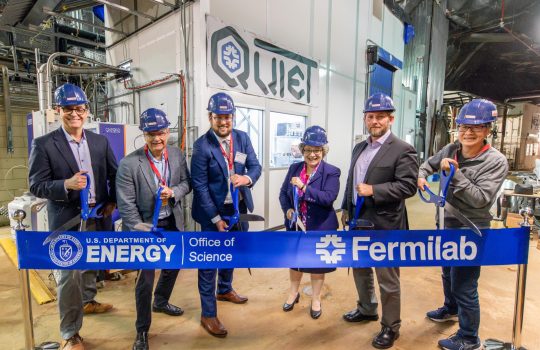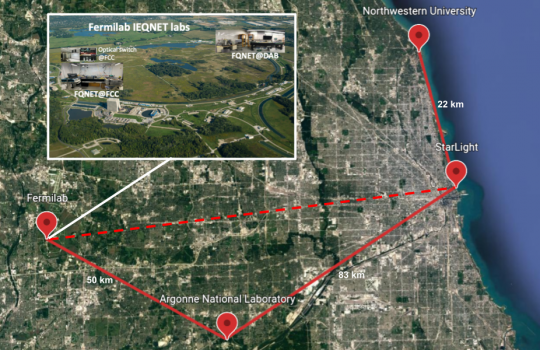
The proposed Illinois Express Quantum Networkis a metropolitan-scale, quantum-classical hybrid design combining quantum technologies with existing classical networks to create a multinode system for multiple users.
The Department of Energy has announced that it will grant Fermilab and partner institutions $3.2 million to develop designs for transparent optical quantum networks and demonstrate their operation in the greater Chicago area.
The proposed Illinois-Express Quantum Network, or IEQNET, connects nodes at Fermilab and proposed nodes at Northwestern University’s Chicago and Evanston campuses. The metropolitan-scale network uses a combination of cutting-edge quantum and classical technologies to transmit quantum information and will be designed to coexist with classical networks.
“Our team brings together researchers who are leading the way in quantum communications, classical networking, quantum devices and fast-timing electronics,” said scientist Panagiotis Spentzouris, head of quantum science at Fermilab and the project’s principal investigator. “That marriage of world-class expertise enables us to develop the new network.”
Fermilab is the lead institution for the IEQNET collaboration, which includes the Department of Energy’s Argonne National Laboratory, Caltech and Northwestern University.
“We have leading quantum technology capabilities at our respective institutions,” said Northwestern University’s Prem Kumar, one of the researchers on the project. “Now we’re combining them to create new opportunities for distributed quantum communications.”
Scientists have previously demonstrated point-to-point quantum communications over short distances — on the order of 10 miles — in fiber-optic cables. IEQNET’s goal is to demonstrate a multinode fiber-optic quantum network that supports multiple users.
“We will be using state-of-the-art sources and photodetectors in nodes we have built already at Fermilab to co-distribute classical and quantum information across Chicagoland,” said Caltech scientist Maria Spiropulu, another IEQNET researcher. “We want to identify and address the challenges toward nontrivial, long-distance multilayered architectures that support multiple end-users and test various protocols.”
IEQNET’s objective supports the United States in meeting the goals of its National Quantum Initiative, a coordinated multiagency program to support research and training in quantum information science. It also positions Chicago as one of the few places in the nation advancing quantum communications. The proposed network stretches between the Chicago area institutions using existing fiber-optic cables.
“We want to utilize existing links because we have significant infrastructure that has already been laid for classical communications,” said Rajkumar Kettimuthu, an Argonne scientist affiliated with IEQNET. “One of the challenges will be to achieve classical and quantum co-existence in the same fibers.”
IEQNET leverages existing conventional infrastructure and experience from ESnet, a high-speed computer network serving DOE scientists and their collaborators worldwide. ESnet is managed by Lawrence Berkeley National Laboratory, also a DOE national laboratory.
The project also brings together small quantum tech industry partners, including businesses such as NuCrypt and HyperLight, and the Intelligent Quantum Networks and Technologies, or INQNET, program, which was developed through a Caltech and AT&T partnership and is a member of the Quantum Economic Development Consortium of the National Institute of Standards and Technology.
By connecting business with academia, IEQNET has the potential to generate new technologies that have wider application in industry, helping elevate the Chicago area as a hot spot for technology transfer in quantum science.
IEQNET is one of the recently announced five four-year projects aimed at developing wide-area quantum networks funded by the DOE Office of Science.
“We are on the threshold of a new era in quantum information science and quantum computing and networking, with potentially great promise for science and society,” said DOE Under Secretary for Science Paul Dabbar in an announcement from DOE. “These projects will help ensure U.S. leadership in these important new areas of science and technology.”



